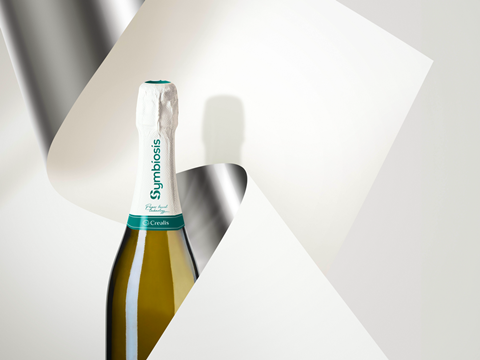
Crealis Group has combined FSC-certified paper and aluminium into sparkling foils for wine packaging – a design set to replace conventional plastic solutions and reduce CO2 emissions.
Instead of the traditional, three-layer Alu/PE/Alu structure of sparkling foils, Crealis’ Symbiosis foils consist of 48% paper and 44% aluminium. Under the European Recycling Code C/PAP82, the foils can apparently be recycled in paper waste streams across Europe.
Compared to an equivalent foil made from Derma75, it is set to reduce CO2 emissions by 30%, or by 15% compared to the latest Derma75 L.
The foils will be on display at Luxe Pack in Monaco from 30th September – 2nd October 2024, as well as other events taking place in Europe.
“This product is extraordinary not only for the quality of its materials, but also because it is the first sparkling foil primary made of paper and available on an industrial scale, using existing bottling lines,” explains Michele Moglia, CEO of Crealis. “Symbiosis is sustainable and feasible – a concrete solution now available to the market.
“Like all our products, Symbiosis is highly customizable and compatible with automatic bottling lines.”
Crealis Group adds that its near-term, science-based greenhouse gas emissions reduction targets were recently validated by the Science Based Targets initative (SBTi). These include reducing absolute scope 1 and 2 greenhouse gas emissions by 42% by 2030, using 2022 as the base year; and, within the same time frame, reducing absolute scope 3 greenhouse gas emissions by 25%.
In similar news, Amcor Capsules has worked with Moët & Chandon to create a foil made of aluminium and paper. The companies aspire for a lower carbon footprint and enhanced recyclability when compared to traditional foil solutions.
Alternatively, UK retailer Waitrose announced its decision to remove all plastic and foil sleeves from its own-brand wine bottle necks last year. The company said that the capsules serve no functional purpose, and that removing them will help consumers more easily access the product – and cut down on unnecessary packaging waste.
If you liked this story, you might also enjoy:
The ultimate guide to the Packaging and Packaging Waste Regulation in 2024
How are the top brands progressing on packaging sustainability?
Sustainable Innovation Report 2024: Current trends and future priorities
Everything you need to know about global plastic sustainability regulation












No comments yet